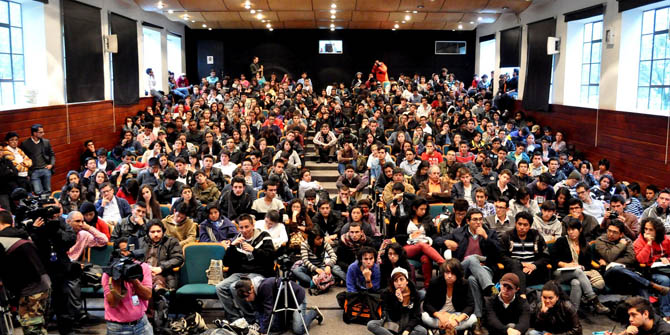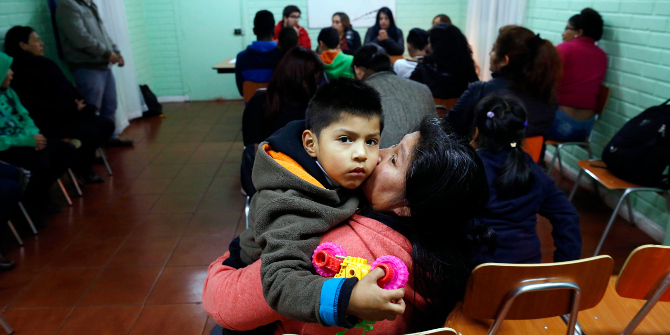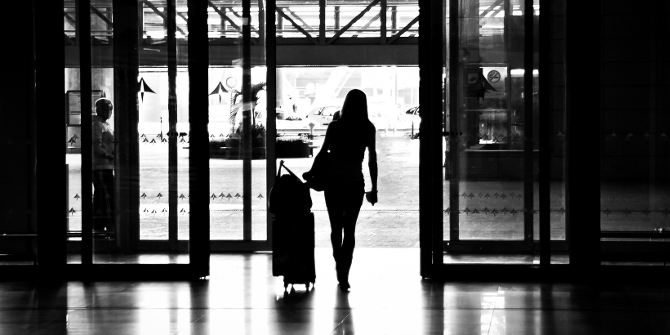 Focusing on the politics of urban security in Bogotá, Austin Zeiderman argues that the relationship between the Colombian state and its citizens is structured around threats soon to be alleviated by the peace process, raising questions about the future of the country’s politics.
Focusing on the politics of urban security in Bogotá, Austin Zeiderman argues that the relationship between the Colombian state and its citizens is structured around threats soon to be alleviated by the peace process, raising questions about the future of the country’s politics.
• Disponible también en español
In Colombia, one of the world’s longest running armed conflicts may be nearing its end. Yet half a century of violence will be difficult to leave behind. Problems linger, and one key point has been overlooked: without insecurity, politics in Colombia may be inconceivable. This is not to say that the peace process should be brought to a halt. Rather it is to suggest that the initiative may have to contend with an unanticipated consequence: if the relationship between the state and its citizens is upheld by existential threats, such as the FARC, what happens when those threats are gone?
When I first arrived in 2006 to begin examining the politics of urban security in Colombia, Bogotá was safer than it had been for quite a while. But there was something paradoxical about this change. The atmosphere was more relaxed, yet many of the same anxieties remained. Friends and strangers alike urged me to see the city as a threat-ridden place and taught me strategies for negotiating it, even drawing me maps that divided the city into “safe zones” and “no-go areas.”

I first assumed it was my status as a bewildered gringo that prompted these warnings. But I soon realised that they reflected a pervasive sense of the city as a space of threat. This extended from obvious precautions, like shutting car windows in traffic, to more eccentric ones, such as covering the mouth and nose to protect oneself from el sereno, a mysterious vapour believed to descend from the mountains at dusk. The further I advanced into the hillside settlements of Bogotá’s southern periphery, where many had advised me not to go, the more pronounced these warnings became.
The key to understanding these warnings and precautions is to see them not as paranoid superstitions but as cultural practices adapted to everyday life in a city perceived to be fraught with danger. After all, it is not long ago that assassinations, bombings, and kidnappings were routine. Those who lived through that Bogotá came to orient their lives in relation to threats of many kinds. Yet at the same time, urbanists and security experts from around the world were heralding the dawn of a new age in Bogotá, and even the city’s “rebirth.”
The subtly different concepts of danger and endangerment offer us a way out of this paradox. Both suggest the possibility of imminent harm rather than its immediate reality. But danger indicates a specific threat, whereas endangerment refers to the more general condition of feeling threatened. Danger is immediate and short-term — it may dissipate when time passes or conditions change. In contrast, endangerment is lasting and open-ended — the possibility of harm is sustained indefinitely.
Endangered City, the book that eventually emerged from this research, is not about the direct experience of danger so much as it is about how endangerment indirectly conditions experiences of the city. This framing is helpful for understanding many aspects of life in Bogotá and other places like it that have emerged from long periods of insecurity, but in particular it sheds light on the domain of politics and government. Conservative political figures have understood security as a fundamental yet elusive right threatened by an internal enemy, which legitimates uses of force and abuses of power. The alternatives proposed by the centre and the left also revolve around the pursuit of security, albeit defined in social and economic rather than military terms.
In Colombia, where security has long been a concern across the political spectrum, a focus on endangerment casts light on how the state establishes and maintains its authority and legitimacy, how the government intervenes in the lives of its citizens, and how these citizens position themselves when addressing the state. It provides a way of apprehending the politics of security, and its implications for cities and urban life.
While my research in Colombia touched on many aspects of urban security, my principal focus was a housing resettlement program run by the municipal government of Bogotá. The program began in the early 2000s with the objective of relocating households living in areas designated “zones of high risk,” for their vulnerability to landslides and floods. The program applied exclusively to those belonging to the two lowest estratos—a socioeconomic ranking the municipal government uses to subsidise essential services and other benefits.

Studies found the peripheral settlements of Ciudad Bolívar (foreground, above) — the largest and poorest of Bogotá’s twenty localities — to be the most vulnerable. Maps were drawn coding the city into zones of low, medium, and high risk. Qualifying residents of high-risk zones would then be granted housing subsidies conditional on their willingness to abandon their homes and relocate. Their constitutional right to “decent housing” was mediated by and predicated on the degree to which their lives were in danger.
This marked the beginning of what would eventually amount to over a decade of urban transformation driven by the imperative to govern (and govern through) risk and security. Thereafter, this imperative would shape the relationship between citizens and the state throughout the self-built settlements of the urban periphery. One of the major changes would be that citizenship, and the rights and responsibilities that come with it, were linked to vulnerability. To be recognised as a citizen with rights, one first had to be visible as a life at risk. In what I call the endangered city, this is often how people, especially the poor, must define and execute their political claims.
I am often asked why someone studying security in Colombia would focus their research on environmental threats rather than human ones and on efforts to protect lives rather than to destroy them. My answer tends to be twofold. First, in a place long synonymous with violence other important phenomena are too often overlooked. And second, a key dynamic of the armed conflict has been the way in which security concerns spread throughout other domains of society. This mutually constitutive relationship between politics and security goes far beyond the conflict itself.
Though my research into the politics of urban security in Colombia predates the current peace process, it provides insights into the legacies of conflict that this process will inevitably confront. What will politics look like once a major source of insecurity, the guerrilla, is no longer a looming threat? What will the relationship between the state and its citizens be based on without the dangers that have long motivated the work of government? Addressing these questions will be no easy task. But it does yield the opportunity to rethink deeply held assumptions about political life, and to consider how it can be lived in times of peace.
Notes:
• This article draws on research for Dr Zeiderman’s book Endangered City: The Politics of Security and Risk in Bogotá
• The views expressed here are of the authors and do not reflect the position of the Centre or of the LSE
• Featured-image credit: modified version of ZONES1 GRAFFITI (CC BY-NC 2.0)
• Main-body photo credit: Wolfgang Sterneck (CC BY-NC-SA 2.0)
• Please read our Comments Policy before commenting
 Austin Zeiderman – LSE Geography and Environment
Austin Zeiderman – LSE Geography and Environment
Dr Austin Zeiderman is Assistant Professor of Urban Geography in LSE’s Department of Geography and Environment. He specialises in the cultural and political dimensions of cities, with a specific focus on Latin America. He is the author of Endangered City: The Politics of Security and Risk in Bogotá (Duke University Press, 2016).





